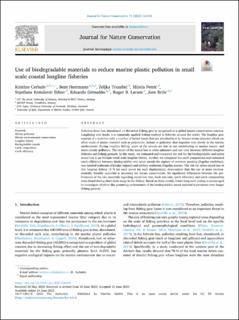| dc.contributor.author | Cerbule, Kristine | |
| dc.contributor.author | Herrmann, Bent | |
| dc.contributor.author | Trumbić, Željka | |
| dc.contributor.author | Petrić, Mirela | |
| dc.contributor.author | Šifner, Svjetlana Krstulović | |
| dc.contributor.author | Grimaldo, Eduardo | |
| dc.contributor.author | Larsen, Roger B. | |
| dc.contributor.author | Brčić, Jure | |
| dc.date.accessioned | 2023-08-14T11:35:37Z | |
| dc.date.available | 2023-08-14T11:35:37Z | |
| dc.date.created | 2023-06-29T10:23:26Z | |
| dc.date.issued | 2023 | |
| dc.identifier.citation | Journal for Nature Conservation. 2023, 74 . | en_US |
| dc.identifier.issn | 1617-1381 | |
| dc.identifier.uri | https://hdl.handle.net/11250/3083846 | |
| dc.description.abstract | Pollution from lost, abandoned, or discarded fishing gear is recognized as a global nature conservation concern. Longlining with hooks is a commonly applied fishing method in fisheries around the world. The longline gear consists of a mainline with a number of baited hooks that are attached to it by thinner twine (snoods) which are often made of plastic material such as polyamide (nylon) or polyester that degrades very slowly in the marine environment. During longline fishing, some of the snoods are lost at sea contributing to marine macro- and micro-plastic pollution. The extent of the snood loss is often unknown and can vary between different longline fisheries and fishing grounds. In this study, we estimated and compared the risk for the biodegradable and nylon snood loss in an Adriatic small scale longline fishery. Further, we compared the catch composition and estimated catch efficiency between biodegradable and nylon snoods for capture of common pandora (Pagellus erythrinus), two-banded seabream (Diplodus vulgaris) and axillary seabream (Pagellus acarne). The risk for nylon snood loss in this longline fishery (3 % for each snood for each deployment), demonstrate that the use of more environmentally friendly materials is necessary for nature conservation. No significant differences between the performance of the two materials regarding snood loss rate, hook loss rate, catch efficiency and catch composition were found during short-term usage in the fishery. Based on these results, future long-term testing is encouraged to investigate whether this promising performance of the biodegradable snood material is persistent over longer fishing periods. | en_US |
| dc.language.iso | eng | en_US |
| dc.publisher | Elsevier | en_US |
| dc.rights | Navngivelse 4.0 Internasjonal | * |
| dc.rights.uri | http://creativecommons.org/licenses/by/4.0/deed.no | * |
| dc.subject | Marine pollution | en_US |
| dc.subject | Marine environmental conservation | en_US |
| dc.subject | Longline fishery | en_US |
| dc.subject | Biodegradable snoods | en_US |
| dc.subject | Catch composition | en_US |
| dc.subject | Catch efficiency | en_US |
| dc.title | Use of biodegradable materials to reduce marine plastic pollution in small scale coastal longline fisheries | en_US |
| dc.title.alternative | Use of biodegradable materials to reduce marine plastic pollution in small scale coastal longline fisheries | en_US |
| dc.type | Journal article | en_US |
| dc.type | Peer reviewed | en_US |
| dc.description.version | publishedVersion | en_US |
| dc.rights.holder | © 2023 The Author(s). Published by Elsevier Ltd. This is an open access article under the CC BY license (http://creativecommons.org/licenses/by/4.0/). | en_US |
| dc.source.pagenumber | 0 | en_US |
| dc.source.volume | 74 | en_US |
| dc.source.journal | Journal for Nature Conservation | en_US |
| dc.identifier.doi | 10.1016/j.jnc.2023.126438 | |
| dc.identifier.cristin | 2159334 | |
| dc.source.articlenumber | 126438 | en_US |
| cristin.ispublished | true | |
| cristin.fulltext | original | |
| cristin.qualitycode | 1 | |

